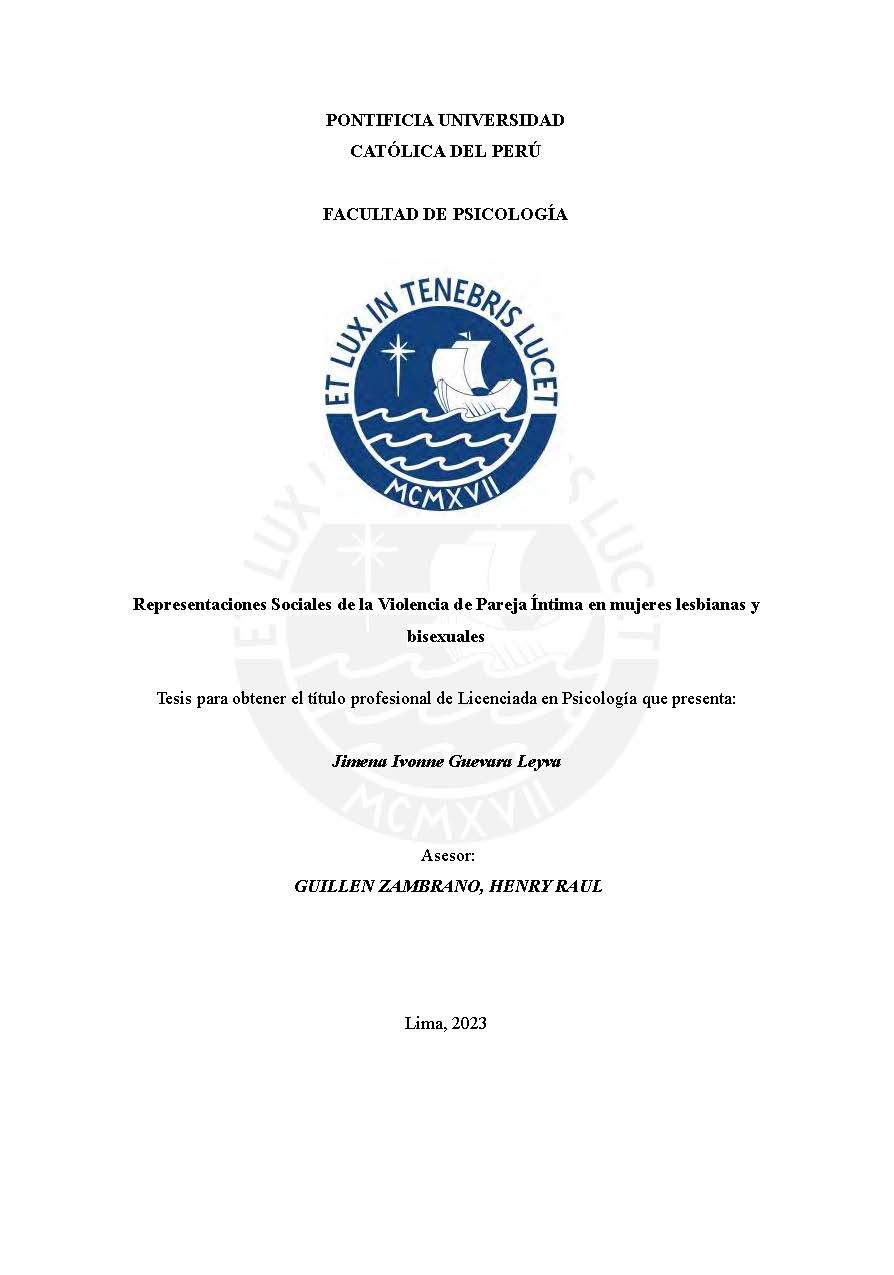| dc.contributor.advisor | Guillen Zambrano, Henry Raúl | |
| dc.contributor.author | Guevara Leyva, Jimena Ivonne | |
| dc.date.accessioned | 2024-01-25T19:25:05Z | |
| dc.date.available | 2024-01-25T19:25:05Z | |
| dc.date.created | 2023 | |
| dc.date.issued | 2024-01-25 | |
| dc.identifier.uri | http://hdl.handle.net/20.500.12404/26947 | |
| dc.description.abstract | La presente investigación tuvo como objetivo analizar las representaciones sociales sobre la
Violencia de Pareja Íntima (VPI) en 8 mujeres, 4 lesbianas y 4 bisexuales peruanas. Las
edades de las participantes estuvieron comprendidas entre los 21 y 27 años. Para el recojo de
información, se utilizó la entrevista semiestructurada, la cual abrió paso a las creencias,
estereotipos y actitudes dirigidas al fenómeno de estudio, e incluía la técnica de los Tris
jerarquizados, que permitió observar el núcleo de la representación. Entre los principales
resultados, se encontró que las relaciones entre mujeres lesbianas y bisexuales (LB) cargan
estereotipos -hostiles y benevolentes-, los cuales impiden que se dé un reconocimiento a la
violencia que sucede dentro de dichos vínculos. Todas estas nociones negativas se basaban en
los roles de género y en la visión de la heterosexualidad como regla. Finalmente, se pudo
observar que estas creencias se encontraban también en la dinámica interna de la comunidad
LGTBIQ+ y, de esa manera, se mantenían diferencias de poder dentro del mismo colectivo,
perjudicando a las mujeres LB. | es_ES |
| dc.description.abstract | The objective of this research was to analyze the social representations of Intimate Partner
Violence (IPV) in 8 Peruvian women, 4 lesbians and 4 bisexuals. The ages of the participants
were between 20 and 27 years old. For the gathering of the information, the semi-structured
interview was used and it opened the way to their beliefs, stereotypes and attitudes directed at
the study phenomenon, and it included the hierarchical Tris technique, which allowed the
observation of the core of the representation. Among the main results, it was found that
relationships between lesbian and bisexual (LB) women carry stereotypes -hostile and
benevolent-, which prevent recognition of the violence that occurs within these relationships.
All of these negative notions were based on gender roles and the view of heterosexuality as
the norm. Finally, it was observed that these beliefs were also found in the internal dynamics
of the LGTBIQ+ community and, in this way, power differences were maintained within the
same group, harming LB women. | es_ES |
| dc.language.iso | spa | es_ES |
| dc.publisher | Pontificia Universidad Católica del Perú | es_ES |
| dc.rights | info:eu-repo/semantics/openAccess | es_ES |
| dc.rights.uri | http://creativecommons.org/licenses/by/2.5/pe/ | * |
| dc.subject | Representaciones sociales | es_ES |
| dc.subject | Violencia de pareja | es_ES |
| dc.subject | Homosexualidad | es_ES |
| dc.subject | Bisexualidad | es_ES |
| dc.title | Representaciones sociales de la violencia de pareja íntima en mujeres lesbianas y bisexuales | es_ES |
| dc.type | info:eu-repo/semantics/bachelorThesis | es_ES |
| thesis.degree.name | Licenciado en Psicología | es_ES |
| thesis.degree.level | Título Profesional | es_ES |
| thesis.degree.grantor | Pontificia Universidad Católica del Perú. Facultad de Psicología | es_ES |
| thesis.degree.discipline | Psicología | es_ES |
| renati.advisor.dni | 47180603 | |
| renati.advisor.orcid | https://orcid.org/0000-0001-6574-8077 | es_ES |
| renati.author.dni | 74283819 | |
| renati.discipline | 313016 | es_ES |
| renati.juror | Guillen Zambrano, Henry Raúl | es_ES |
| renati.juror | Pecho Ricaldi, Priscilla Luz | es_ES |
| renati.juror | Pease Dreibelbis, María Angelica | es_ES |
| renati.level | https://purl.org/pe-repo/renati/level#tituloProfesional | es_ES |
| renati.type | https://purl.org/pe-repo/renati/type#tesis | es_ES |
| dc.publisher.country | PE | es_ES |
| dc.subject.ocde | https://purl.org/pe-repo/ocde/ford#5.01.00 | es_ES |






